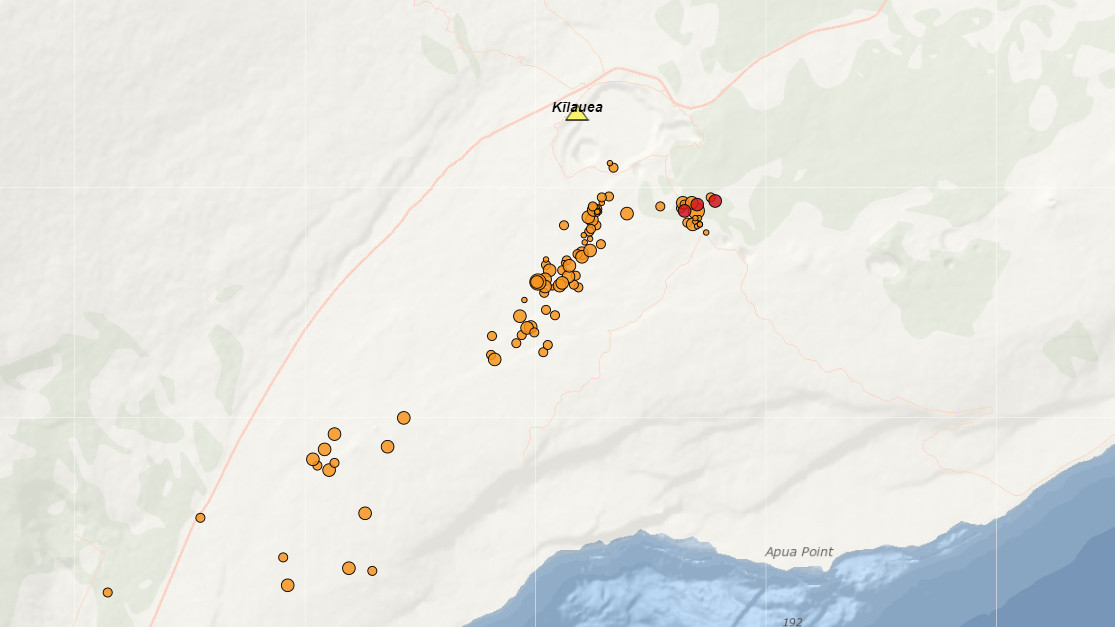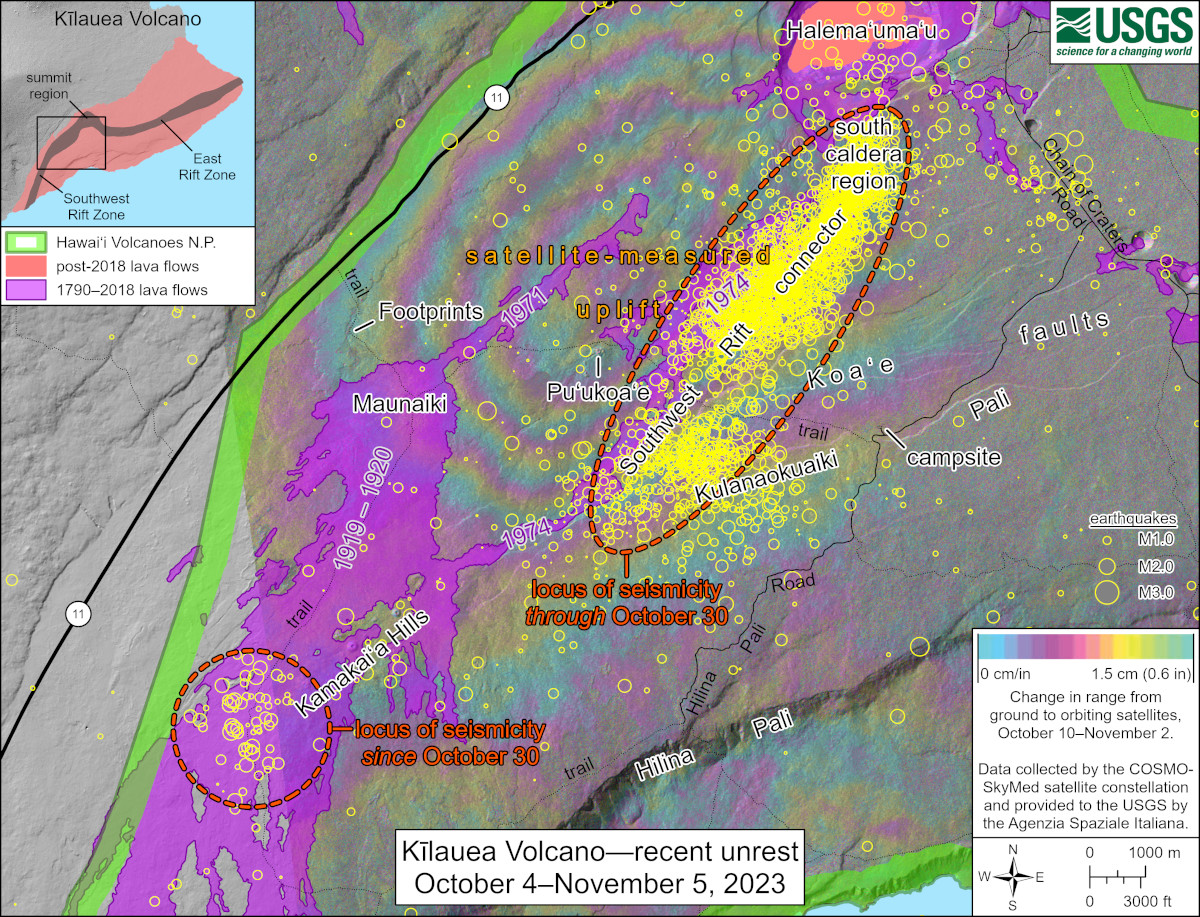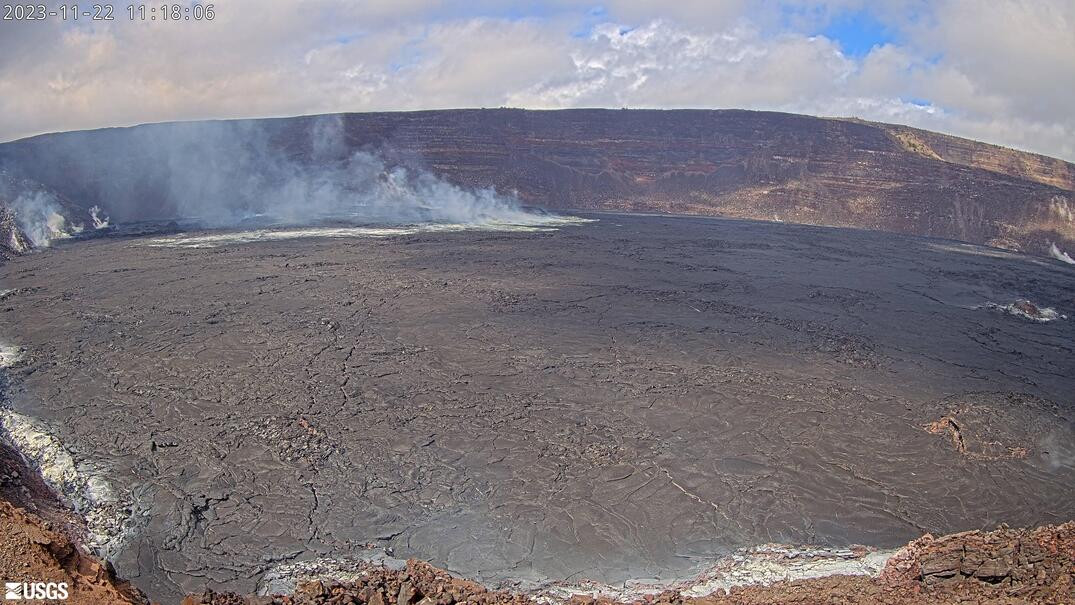This story appears in the above BIVN Update. The video will jump to the associated story when played. (A synthesized voice was utilized in the narration for this story)
(BIVN) – Kīlauea is not erupting, however the volcanic unrest continues.
Scientists reported Wednesday that the rapid increase in seismicity that began around 8 a.m. Tuesday slowly subsided throughout the remainder of the day. The activity that was observed in the upper East Rift Zone (ERZ) – which led to some area closures within Hawaiʻi Volcanoes National Park yesterday – returned to normal on Wednesday, and appeared to shift “to the region extending from the south end of the caldera, southwest to the Koa’e fault zone that has been typical of the past month.”
Shortly after 10 a.m., the National Park Service announced rangers reopened Chain of Craters Road and nearby sites, after the USGS said the “brief seismic crisis” in the upper ERZ has subsided.
However, the interactive map on the USGS webpage at 11 a.m. shows there is still some seismicity occurring in the upper ERZ.

USGS interactive map as of 11:15 p.m. HST. The three most recent earthquakes in the upper ERZ (red) occurred between 10:23 a.m. and 11:01 a.m. HST.
The volcano alert level for Kīlauea remains at ADVISORY.
From the USGS Hawaiian Volcano Observatory:
Activity Summary: Kīlauea volcano is not erupting. The rapid increase in seismicity that began around 8 a.m. yesterday (November 21) slowly subsided throughout the remainder of the day. By early evening, most seismic activity had returned to the region extending from the south end of the caldera, southwest to the Koa’e fault zone that has been typical of the past month. Unrest may continue to wax and wane with changes to the input of magma into the area and eruptive activity could occur in the near future with little or no warning. No unusual activity has been noted along the middle and lower sections of Kīlauea’s East Rift Zone.
Summit Observations: The rapid onset of seismicity that began around 8 a.m. yesterday (November 21) in the upper East Rift Zone gradually subsided throughout the day and has returned to more normal activity this morning, Wednesday, November 22. In the past 24 hours, 55 earthquakes with magnitudes up to 3 occurred in the upper East Rift Zone mostly from 8 a.m. to 8 p.m. November 21. In the past 12 hours, there have only been 13 small earthquakes in the upper East Rift Zone with magnitudes less than 1. As activity waned in the upper East Rift Zone, seismicity returned to the region extending from the south end of Kīlauea Caldera southwest to the Koa’e fault system. There were 130 earthquakes in the region over the past 24 hours, with 90 of them occurring in the past 12 hours.
The Uēkahuna summit tiltmeter, located northwest of the caldera showed a increase in inflation beginning around beginning around 2 a.m. this morning, November 22. The Sand Hill tiltmeter, located southwest of the caldera, which had been tracking inflation flattened out around 2 a.m., the same time the Uēkahuna tiltmeter began to increase. Overall, the summit of Kīlauea remains at a high level of inflation, above the level reached prior to the most recent eruption in September 2023, and the highest level since the 2018 eruption.
Sulfur dioxide (SO2) emission rates remain low. Field observations found SO2 gas emission of 100 tonnes per day on November 17th. This is the same as an observation in October 2023.
The brief seismic crisis in the upper East Rift Zone subsided throughout the day yesterday November 21 greatly reducing any chance of eruptive activity. There is currently no sign of an imminent eruption, and seismic activity has returned to the region extending from the south margin of the caldera southwest to the Koa’e fault zone typical of the activity during the past two months. An increase in seismic unrest would be expected prior to any eruptive activity in this region. The onsets of previous summit eruptions have been marked by strong swarms of earthquakes caused by the emplacement of a dike 1-2 hours before eruptions and these have not been detected at this time.
The HVO information statement released on October 23, 2023, provides additional information and context related to recent unrest at Kīlauea summit.

USGS: “This map shows recent unrest at Kīlauea’s summit and Southwest Rift Zone. Yellow circles denote earthquake locations from October 4–November 5, 2023, as recorded by HVO seismometers. Through October 30, most of these events were occurring closer to the summit in an area known as the Southwest Rift connector, but since October 30 there has been a slight increase in seismicity below the Kamakaiʻa Hills in the middle Southwest Rift Zone. Colored fringes denote areas of ground deformation from October 10–November 2, as measured by satellite radar. Each color cycle represents 1.5 cm (0.6 in) of ground motion toward the satellite, indicating uplift associated with a magmatic intrusion.”
Rift Zone Observations: Beginning in early November, a small cluster of earthquakes (4-12 earthquakes per day) began occurring along the Southwest Rift Zone. Most events have been smaller than magnitude-2 and have located in the middle of the Southwest Rift Zone, at depths of 1-3 miles (1-5 km) below sea level. This morning, a swarm of earthquakes, including four larger earthquakes, began on the upper East Rift Zone. The 4 largest earthquakes occured in the south caldera (M2.8), southwest of the caldera (M2.0) and upper East Rift Zone (M3.2 and M2.8).
We continue to closely monitor this area. There have been several minor episodes of seismicity in the Upper East Rift Zone in the past month, but no unusual activity has been noted along the rest of the East Rift Zone. Measurements from continuous gas monitoring stations downwind of Puʻuʻōʻō in the middle East Rift Zone have been below detection limits for SO2, indicating that SO2 emissions from Puʻuʻōʻō are negligible.


by Big Island Video News11:45 am
on at
STORY SUMMARY
HAWAIʻI VOLCANOES NATIONAL PARK - The rapid increase in seismicity that was observed on Tuesday has subsided, however the unrest continues at Kīlauea.